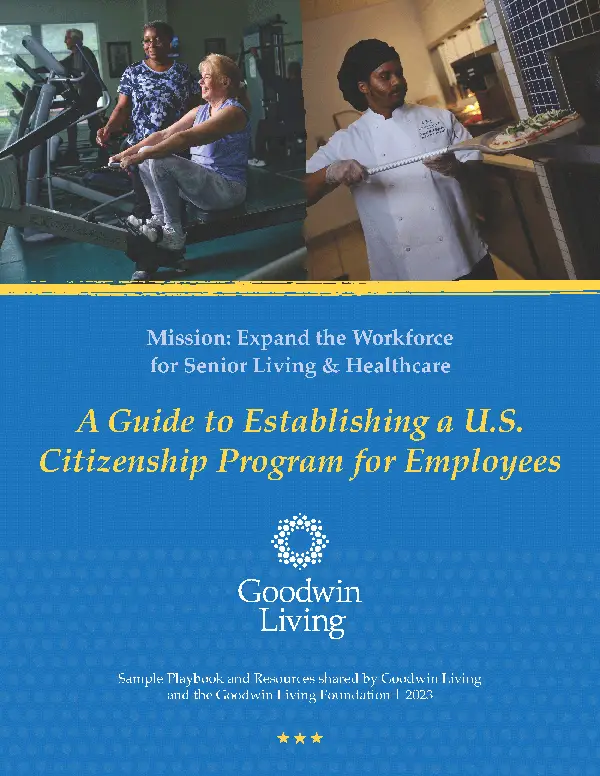
Live Vibrantly - October 31, 2024
By Abigail Hanlon
Creativity is a part of our daily lives, often a larger part than we realize. Whether it’s humming to yourself in the elevator, doodling on the edge of a newspaper crossword or dancing in your apartment like no one is watching, being creative is a part of being human. The creative arts have helped us express ourselves, overcome challenges and connect with one another since the dawn of our existence.
In recent years, a new field has emerged, one that harnesses the power of the creative arts paired with psychotherapy theories and techniques. Creative art therapies (CATs) use the modalities of music, art and dance/movement to help individuals achieve their personal therapeutic goals. Recently, Goodwin House Alexandria (GHA) launched a CATs department to support residents and team members.
Our CATs department is a small group dedicated to providing creative arts therapies for all three levels of living at GHA. In the coming year, the CATs department will provide education about how each modality offers benefits for the aging process. The CATs department will also explore more ways to bring all three modalities to the campuses and develop programming and events for all team members and residents.
The creative arts therapies movements were born out of the 1940s and 50s during the post-World War II era. Music therapy was used to help veterans recover from post-traumatic stress disorder. Dance/movement therapy was used to help individuals recovering from mental illnesses. Art therapy began to help people express their subconscious. These therapies became the subject of research studies and continued to grow in popularity and recognized validity over the following decades.
At Goodwin Living, the creative arts therapies started a few years ago. We established the music therapy program in 2022 through generous donations to the Goodwin Living Foundation. It quickly grew in popularity and participation, opening the door for more investment in this and other CATs modalities to support the dynamic needs of older adults.
Music Therapy uses music-based techniques in a therapeutic setting to help people reach their unique goals. It’s guided by a trained professional who has completed an accredited music therapy program and tailors the approach to each individual’s needs.
As a certified music therapist, I use singing as one of my favorite tools when engaging residents during music therapy sessions. I remember one session in particular: a resident felt frustrated when they struggled to enunciate words and communicate. We started the session by singing songs that they knew from their childhood and late teens. As the music began, the resident quietly sang the words. They recalled all of the words and sang clearly. There was a sense of pride on their face as they sang.
Goodwin Living offers a wide range of musical programming. We use music therapy to help residents maintain their cognitive and physical abilities through adaptive bell choirs and “music & movement” groups. We also create spaces for residents to emotionally express themselves through singing and playing instruments. Additionally, we have created a specialized choral program, The Melody Makers Choir, that is tailored to residents with mid to late-stage dementia.
It doesn’t matter if people can carry a tune; what matters is that they sing anyway. Music involves multiple areas of the brain, which allows it to bypass areas that are damaged due to cognitive decline, stroke or other brain injuries. This is why music and singing are incredibly important for those looking to maintain or improve their cognitive health. In addition to cognitive benefits, engaging in music-making also benefits our physical and social health. Making music with other people allows us to interact with others in a different way. We can use music to connect with one another or find support from one another, which is incredibly important during our older adulthood.
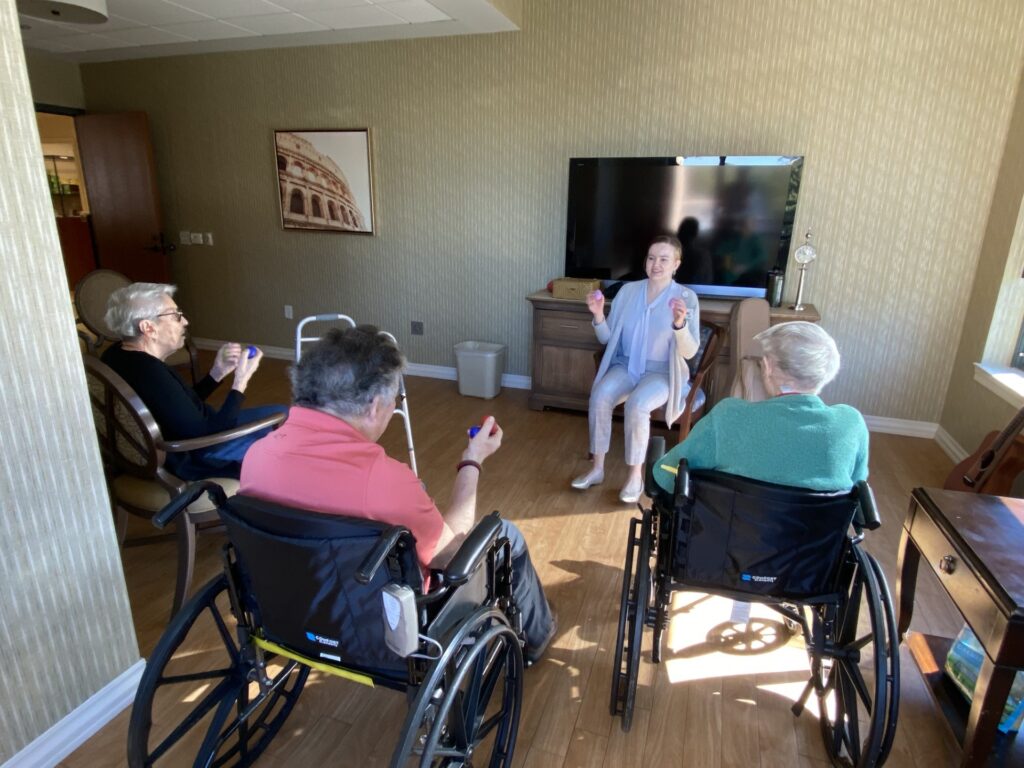
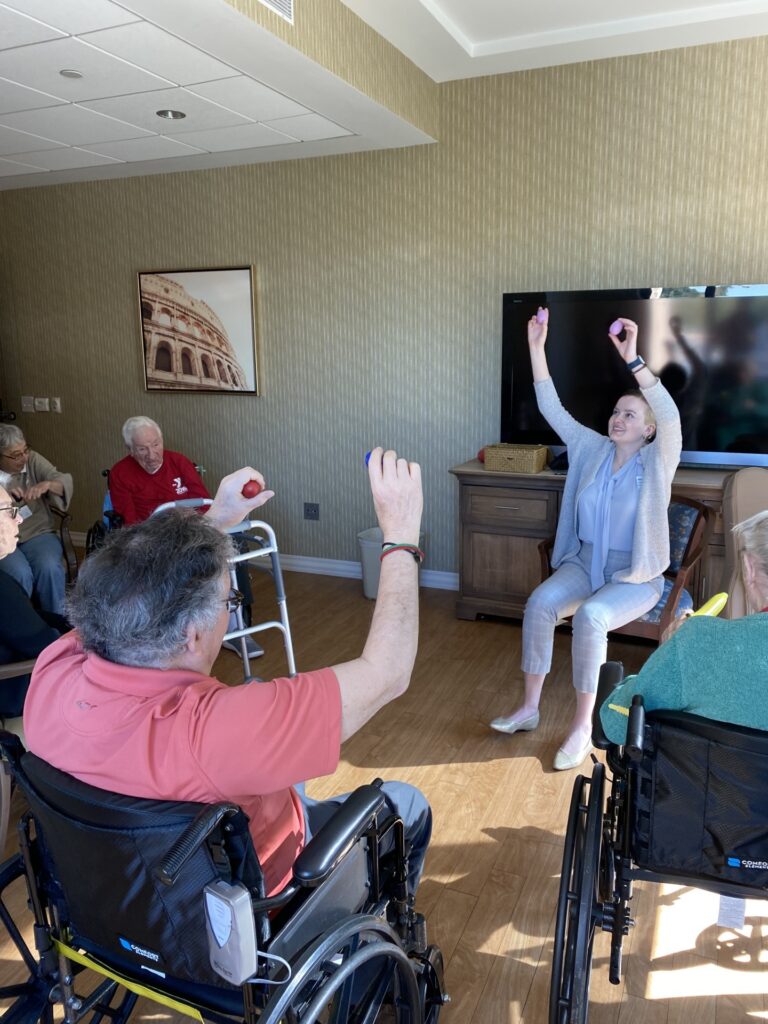
Dancing can also positively affect the wellbeing of older adults. Columbia University neurologist John Krakauer traces the pleasure of dancing to the brain’s processes of mirroring and shared social experience.
We’re constantly learning from experts in the field about ways to support older adults more effectively. For example, Ali Schrechter, a registered dance movement therapist and licensed creative arts therapist in New York who specializes in working with older adults, notes that both music and dance stimulate the brain’s reward or pleasure centers. A 2021 study in the Frontiers in Human Neuroscience journal also found that not only are the pleasure centers of the brain activated, dancing is more likely to lead to “enhanced interpersonal coordination” and “neural synchrony” with others.
Schrechter recalls a particular resident, “M,” at Hebrew Home in Riverdale, New York. M had been a dancer throughout her life, but due to recent health changes she developed limited mobility and became withdrawn. In one dancing/movement therapy session, M responded to a Henry Belefonte song and began dancing with her whole body. Using her body, she expressed joy and energy as she danced. Two years later, M is doing well and still dancing. Schrechter notes that dance movement therapy provided M with “a forum of self-expression, leadership and a restored sense of purpose: a place to feel vital and valued.”
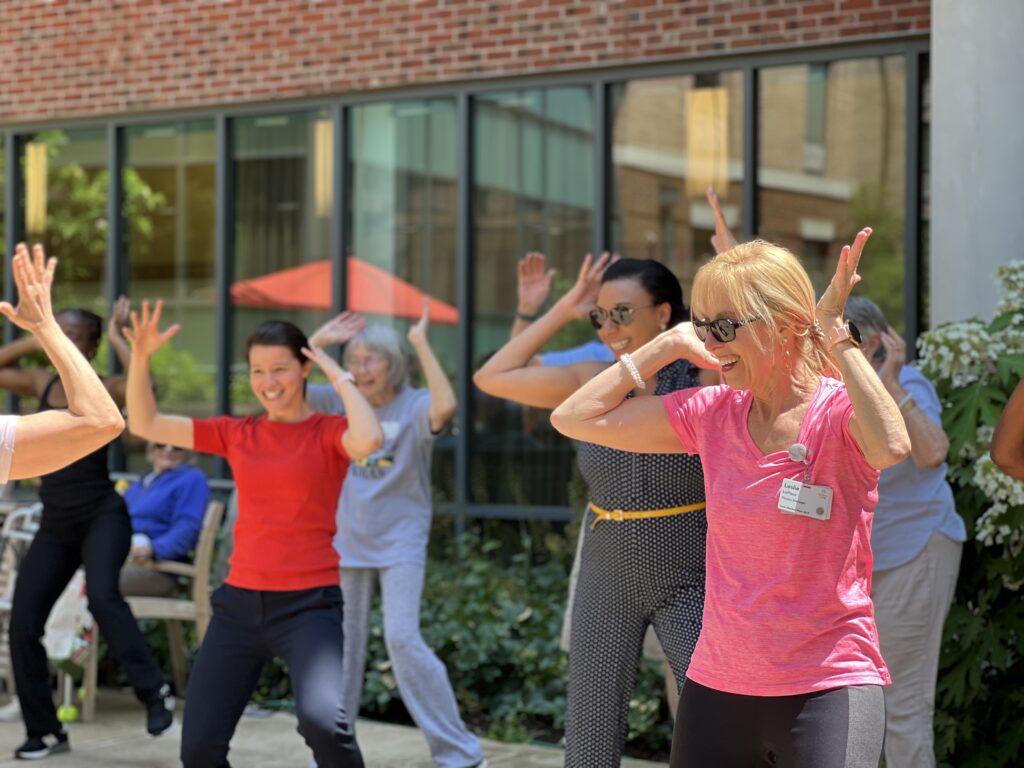
Although dance/movement therapy has not made its official debut at GHA, we have learned and implemented multiple opportunities for residents and team members to move and groove. The GHA line dancers have two groups―beginners and advanced―that meet regularly. There are also multiple yoga classes and other fitness classes geared toward keeping residents moving in a variety of ways. We look forward to developing even more dance/movement programming soon.
Art therapy isn’t just making art; there’s science behind why it makes us feel good or even help us cope with physical pain. Art therapy can lower the perception of pain by moving our mental focus away from painful stimuli. In a study conducted in 2018, researchers found that engaging in art therapy for approximately 50 minutes significantly lowered pain and anxiety and improved the moods of people who were hospitalized post-surgery. Like music therapy and dance/movement therapy, art therapy can provide individuals with a space to express themselves when words may fail. It can also increase self-awareness, promote healthy grieving and create opportunities to focus on abilities and building strengths.
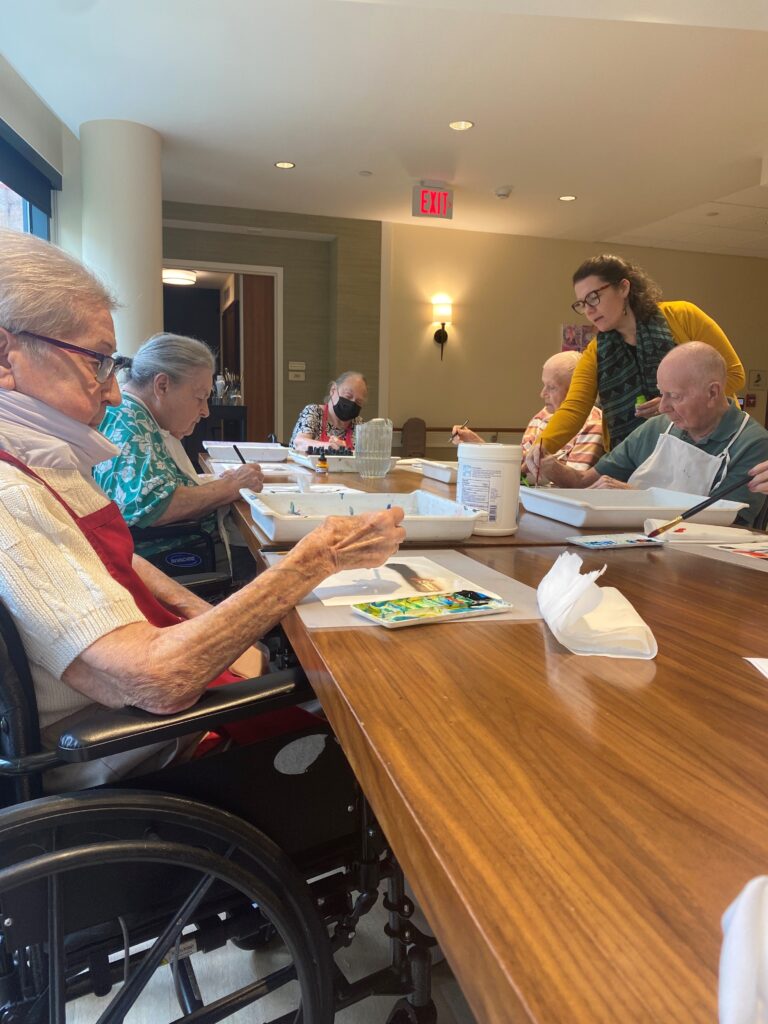
At Goodwin House Alexandria, art therapy reaches the lives of residents from all levels of living. In collaboration with George Washington University art therapy program, art therapy interns provide art therapy group and individual services. Art therapy provided residents in memory support with positive sensory stimulation and alternative methods for self-expression. Art therapy interns also meet individually with residents in the healthcare center where art making is used to process residents’ experiences living in a skilled nursing environment. Additionally, art therapy interns support independent living residents in the art studio during art classes.
Not only do creative arts therapists work within their own modality, they also often collaborate with one another. For example, the GHA Art & Sound meditation group is a collaboration between music therapists and art therapy interns. This weekly program involves making art in response to music and meditation. The art materials and music change each week, though the goal is the same: to encourage residents to enter a state of flow and explore the materials and sounds around them. This program recently took place during Active Aging Week at Goodwin House Bailey’s Crossroads (GHBC) as well. Together, residents created artistic responses to music and then collectively placed them on a canvas to create a visual symphony.
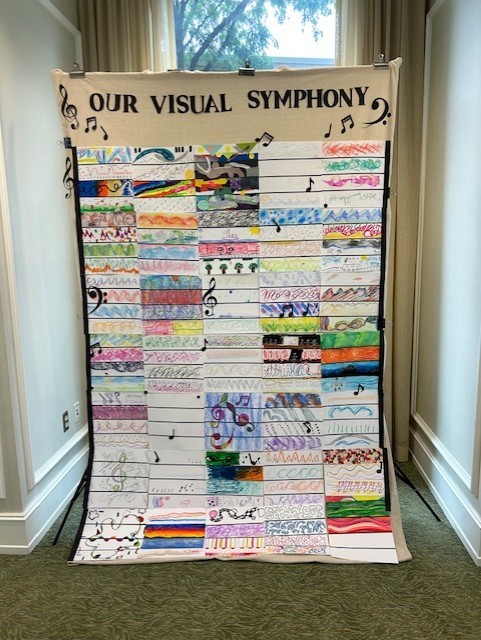
When I work with residents throughout the week, I often hear a lot of statements like, “Oh, I can’t carry a tune” or, “When I was younger, I was told never to sing or play music again.” Statements like these are common but sometimes hard for me to hear. The creative arts are for everyone, no matter how well you can sing, draw or dance.
Ultimately, the creative arts aren’t just something we do only when we’re good at them. They aren’t merely an add-on or reward when it comes to our health and wellness. They’re essential to building and sustaining a balanced wellbeing, especially as we age. The creative arts therapies department at GHA is growing to reflect the needs of residents by providing education, facilitating engaging and effective programming, and providing spaces for residents to explore the creative arts freely and without judgment. By doing so, we hope to support residents’ aging journeys holistically and creatively.
Here at Goodwin Living, everyone has space to explore the creative arts and engage in creative arts therapies. There’s no pre-requisite to obtain the benefits of singing, making art or dancing!
As creative arts therapies continue to grow in popularity, Goodwin Living encourages people of all ages to continue to sing loudly, dance often and make art proudly! Research shows it’s good for your health!
__________________________________
As the Music Therapist, Abigail R. Hanlon uses music to enrich the lives of residents throughout all levels of care at Goodwin House Alexandria. She facilitates music therapy groups, leads the bell choir in the healthcare center, and maintains the Heartbeat Recording Project. Abigail also supports the Melody Makers choir, a choral experience for those in memory support. Originally from Pennsylvania, Abigail attended Marywood University in Scranton, PA, for a bachelor’s degree in Music Therapy. She became board-certified in 2019 after completing her internship at the Children’s Hospital of Philadelphia. Later, she earned her master’s in Music Therapy and Mental Health Counseling from Drexel University in Philadelphia, PA, where she developed a passion for research and working with older adults. Abigail joined the Goodwin Living team in November 2021. She also recently became a Resident in Counseling in Virginia in 2023 and is working towards her mental health counseling license. Outside of work, she enjoys making art, baking, spending time with loved ones, and being in nature.
